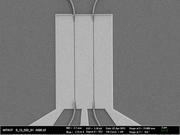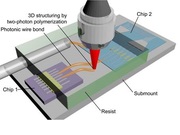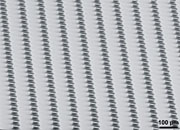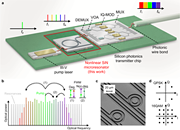Teratronics and Photonics
The research of the Koos group aims at photonic integrated circuits. Just like microelectronic devices, photonic integrated circuits allow to combine hundreds or thousands of optical components on a single microchip, thereby enabling systems that are particularly compact, cost-efficient and robust. The activities cover technologies as well as applications of photonic integrated circuits. On the technology level, ongoing projects aim at hybrid photonic devices that merge the strengths of complementary material systems such as silicon, III-V semiconductors, silicon-nitride or polymers, at novel concepts for photonic multi-chip integration using three-dimensional nano-printing techniques, and at compact and robust integrated frequency comb sources. On the application side, we explore energy-efficient high-speed communications, industrial sensing and metrology, life sciences and teratronics.
Nanophotonic and Teratronic Devices
 |
Nanophotonics employs fundamental opto-electronic principles of light-matter interaction to implement novel functionalities on chip scale at lowest footprint, lowest energy consumption and highest operating speed. The focus is on design, fabrication and characterization of Silicon Photonic and Plasmonic devices in our state-of-the-art cleanroom facilities and characterization laboratories. Teratronic devices ultimately target at the generation, processing and detection of data at rates in the Tbit/s regime and of signals with THz bandwidths. To this end, novel nanophotonic and electronic methods are developed. |
3D Photonic Integration
 |
Photonic wire bonds fabricated by 3D lithography enable the seamless combination of various photonic integration platforms, for e.g., to realize high-speed energy-efficient transceivers. This new fabrication technology enables low loss interconnects with a high density without the need for active alignment. Further research in our group focuses on the fabrication of 3D micro-photonic components for freespace applications, such as lenses, prisms and micro-mirrors. |
Biophotonic Sensors
 |
The goal of this interdisciplinary research group is to develop photonic sensor systems for applications in chemistry, biology, and the life-sciences. The developed sensors are based on active and passive microoptical cavities, which are integrated on a chip with microfluidic structures. The major research objectives are optimization of the sensors for high sensitivity, low analyte consumption and easy handling but also include low-cost production to enable use of the chips as disposables.. |
Teratronic Signal Processing
 |
The Teratronic Signal Processing Group specializes in pushing the technological limits of the on-chip signal processing into the Tbit/s regime using high-speed plasmonic modulators and detectors which exploit the high non-linearity and fast response of electro-optic polymers. The group develops devices cutting-edge technology using its state-of-the-art fabrication facilities available on campus. |

